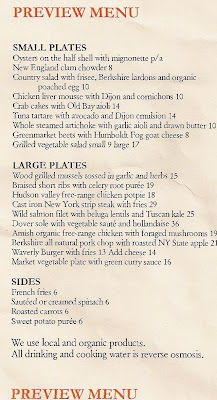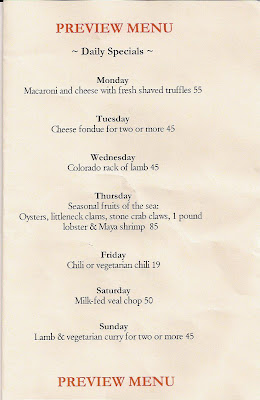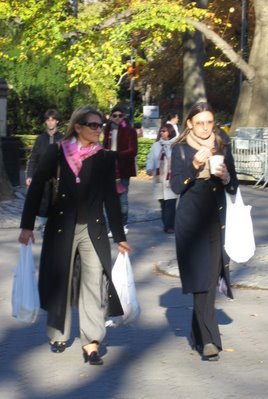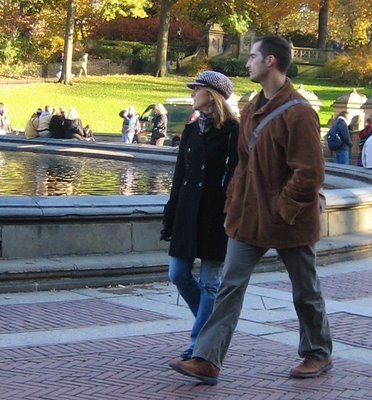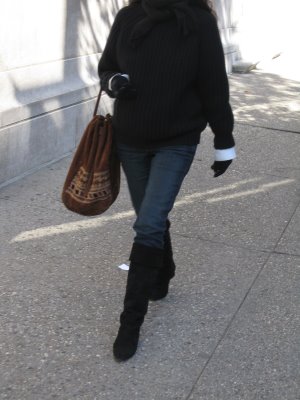Tag Archives: New York
Winter in Union Square
Most New Yorkers seem to be more concerned with staying warm than looking fashionable these days, though some managed to do both. Bomber hats with earflaps are incredibly warm and in style; if you want one and can’t find any left in Manhattan, they’re available for $32 on L.L.Bean. Other trends: white sneakers with skinny black pants, mirrored aviator sunglasses, silver, 80’s jewel tone colors, and cold feet – flats and leggings leave a sliver of skin exposed.
Del Posto Enoteca
The room is hushed. Piano music tinkles in the background. Nearly everybody in the joint is talking business over a nice bottle of red and a good Italian meal. But the place is so well soundproofed, carpet and cushions everywhere, foam padding the underside of the tablecloths, you couldn’t even hear the guy at the table next to you if he was planning a hit. Now if only Artie would quit coming by with that pathetic bandaged hand of his and going on and on about the specials.
That last part didn’t happen. But all night at Del Posto Enoteca, we felt as if it might. Having read about the enoteca on one of Ed Levine’s top 2006 lists for its $41 prix fixe, I expected Del Posto’s to be like the front room at Gramercy Tavern – an energetic, casual setting with diners spilling over from a bar that stretches along one side of the room. Del Posto has the long bar, but the dining space surrounding it has the muted, formal feel of a suburban Italian restaurant that prizes itself on being “the best” in the area. My chef friend mentioned the Sopranos, and from then on I couldn’t help thinking of the place as a mega-Vesuvio’s, Artie’s dream come true.
Unlike Vesuvio’s, Del Posto is known for its great food, so we came in with high expectations. These were matched by the first course and gradually deflated by the ones that followed. Was it just an off night? Give me an expense account and I’ll give you an answer. But there was no doubt this was a Mario Batali operation when lardo, which first appeared on the table as a spread for bread, reappeared decadently drizzled all over the beef carpaccio, which had a fabulous sashimi-like texture. Lift up the carpaccio, and underneath you’ll find a pool of wonderfully fragrant extra-virgin olive oil. Tender, delicate calamari came fried in the lightest tempura-like batter and had a lingering spiciness from the cherry peppers and lemony tang from the capers. The octopus with fried celery and beans was tender and sweet.
Moving on to the primi, we got into wildcard territory. The veal and cauliflower ravioli were amazing, but the bucatini was a strangely bright shade of red and had too much heat and salt. Was Del Posto trying to do a version of Sara Jenkins’ red wine spaghetti at 50 Carmine (R.I.P., 50 Carmine) with an inadvisable cherry pepper reduction? The gnocchi with ragu bolognese, with its subtle hints of fennel and nutmeg, was much more successful.
Who would order the best entree? It turned out to be the fiancée of the Master Orderer, who, as was mentioned in this Café Gray review, always manages to order the best dishes on the menu by employing some sort of gastronomic ESP. His skill must have rubbed off on her, since she was enjoying the bass with lentils as my chef friend picked at her so-so cod. The lentils introduced a nice new flavor to the mix, which was beginning to taste of the same few base notes after three courses. Also – and I can’t believe I am saying this, since I am a confirmed saltaholic – many of the dishes at Del Posto Enoteca were oversalted. The lentils were the one ingredient that could cut through the salt. My steak braciolona, which, though it was cooked rare, tasted only of the red wine marinade through and through (and some more salt). We pronounced it “weird.”
The service was also strange. Extremely attentive one moment but M.I.A. the next, our waitress seemed to realize at one point that we were waiting 30 minutes between courses after the enoteca got slammed at 8 o’clock. She refilled our wines-by-the-glass for free, which was particularly fortunate because the wine there can run $24 a glass. Next time I’ll order a bottle.
Fiancée of Master Orderer again triumphed at dessert with the rich chocolate cake that tasted of amaretto. My chef friend managed to break through the shell of her tarte without the assistance of a jackhammer, though it was a challenge. And by then I had a cold coming on, so all that I could taste of the gelato was that it was cold and vaguely chocolatey.
As we were leaving, we saw a lone woman with short, fluffy hair, reading glasses and a pink cashmere scarf sitting at the bar, staring out into space. No one in Del Posto’s businessman clientele seemed to recognize her, but we stopped by to say hello to Lidia Bastianich. I hope she scolds her sous-chefs as she scolds her television audience about oversalting .
I bid my girlfriends goodbye, trundled into my new Porsche station wagon (paid for in cash), and sped off towards the Holland Tunnel.
 Del Posto Enoteca
Del Posto Enoteca
85 Tenth Avenue, between 15th and 16th Streets
212-497-8090
Ye Waverly Inn
I was there the night Ellen Barkin threw a glass of water in Ronald Perelman’s face. Sadly, I didn’t see it happen, but that was all the inspiration I needed to keep coming back to the Waverly Inn.
With Page Six headlines like this one, most New Yorkers would be hard pressed to say they’re attracted to the Waverly Inn for the food alone. After a slightly rocky start, the kitchen is turning out meals that are “surprisingly good,” as Nathan Lane would say. It’s Yankee cuisine – very American, with British touches. The prices are low, as they were to attract artists when the Olde place first opened.
But first, the setting, because this is one of the most special interior spaces in New York. The buiding itself dates to 1845, though it didn’t house the Waverly Inn until 1920. The inside retains the low ceilings and slanted floors of the olde Waverly Inn. The gray-maned owner Graydon Carter often holds court in the see-and-be-seen front dining room, which winds back into little nooks and opens into a second dining room with a fireplace (an excellent place for a tryst, if only there weren’t so many media people around). Antiqued mirrors give way to more walls painted ruby red, and an elaborate mural of various famous people in sometimes lewd poses of Greek revelry snakes along the far wall. The dining room feels more like old London than any place I’ve been in New York. It’s truly a wonder.
A brief survey of the food, since, as mentioned, it’s not really the point. The frisee salad has just the right lemony, vinegary tang to balance the creaminess of the poached egg, and the lardons are toothsome. The vegetable plate won’t win any prizes for presentation – it arrives as a slew of sauteed vegetable nubs – but it certainly tastes good. A moment of reverence for the biscuits. So light and flaky, they are the ultimate Yankee version of a non-buttermilk biscuit. It would take superhuman willpower to resist devouring the whole thing, especially when it’s slathered with the sweet butter that comes alongside. I’ve only seen the popovers at the Harvard Club inspire the same kind of fanatacism.
The chicken pot pie is an Olde Waverly Inn standby. The creamy chicken stew inside is exactly what it should be, if a little bland. But the pastry! The crust that tops the pie makes the whole dish. It makes me want to burst into the kitchen and demand, “Who are you?” to the pastry chef.
One signature dish here, the macaroni and cheese with shaved truffles, was once just the Monday special but is now available every night (see preview menu, below). I didn’t get it, alas, because I loathe truffles, but everyone else seems to think it’s great. My friend opts for the tuna tartare, and like most of the dishes here, though it isn’t wildly creative, it is fresh and well put-together.
A note on getting in: Though the restaurant is still “not open,” it is possible to eat there if you frequent the bar until the staff recognizes you, and it also helps if you live in the neighborhood. If you don’t know where the intersection of Bank and Waverly is, that’s probably a sign that you should do the rest of us a favor and just stay away.
Ye Waverly Inn
16 Bank Street, at the corner of Waverly
212-243-7900
Telluride, CO – Ski Chic
Ski wear has returned to a nostalgic 70’s palette. Brown, retro plaids, and camo were the most interesting looks on the slopes, with Burton-clad boarders leading the way. All white was also a natural choice.
Uniqlo
The fabled Uniqlo has at last arrived. One of the biggest retailers in Japan, Uniqlo is basically Gap infused with Japanese panache. In the brand’s cavernous global flagship store, I counted fourteen colors of the women’s cashmere sweaters, lightweight with a price point to match. These come as crewnecks, v-necks, and turtlenecks, while other mixed-blend sweaters come in trendier styles – sweater dresses, belted sweaters, or open-knit tops.
Upstairs and downstairs you’ll find lots of puffy winter jackets. The kids’ selection is not so great, but the men’s store is fantastic, especially if you’re looking for gifts. It would be hard to go wrong here – there are tons of sweaters Dad would like, but also funkier zip-up fleece styles even a teenager wouldn’t sneer at.
Uniqlo
546 Broadway between Prince and Spring Streets
917-237-8800
Burton NYC
Put Paragon aside for a minute and consider Burton NYC before you stock up for a winter trip. The store has a great array of fun and functional jackets, gloves, fleeces, hoodies, and socks for snowboarders and skiers alike. I walked out with some Fair Isle ski socks and this candy-cane-colored bonded fleece – “bonded” presumably refers to the surface of the jacket, which is sleek, not fuzzy – for $99.95.
They also sell luggage, racks and racks of Burton snowboards (duh), and cool goggles by Anon that would not be an embarrassment on the slopes.
Burton NYC
106 Spring Street at Mercer Street
212-966-8070
Papatzul
 Just the idea of Mexican food can bring out the worst in New York diners and restaurant owners alike: the former tend to be more interested in a tequila-fueled good time than what’s on the plate, and the latter have been known to pack ’em in and overcharge ’em, unless, of course, they’re keeping out the hordes with an aggressive bouncer and a velvet rope.
Just the idea of Mexican food can bring out the worst in New York diners and restaurant owners alike: the former tend to be more interested in a tequila-fueled good time than what’s on the plate, and the latter have been known to pack ’em in and overcharge ’em, unless, of course, they’re keeping out the hordes with an aggressive bouncer and a velvet rope.
Not so with the low-key Papatzul, just opened on Grand Street in SoHo, in the space that housed La Jumelle. The beautiful old oak bar is still there, and behind it is a bartender so friendly that we decide to have our entire meal perched in front of him. The dining room doesn’t seem very warm, somehow, and there we might be serenaded by the band, the members of which inform one of us, in Spanish, that they are decidedly not a mariachi band, but a serious group of performers. This distinction is one Papatzul itself faces, and at times, it teeters on the border: fun and slightly campy vs. serious Mexican.
People like to judge Mexican restaurants by their guacamole and margaritas. To be honest, I don’t think there’s that much difference, in such simple concoctions, between good guacamoles/margaritas made with fresh ingredients, except that each has its own style. Papatzul’s guacamole is bright and citrusy, flecked with dark green minced chili peppers when ordered medium spicy. The margaritas have the bite of fresh lime without too much sugar. The menu is limited, but many of the items on it are lighter, authentic Mexican fare. In the ensalada palmito, each element shines – the briny pickled hearts of palm hit just the right note against the sweet slices of pear. The chilapitas de camarones – tortilla cups of shrimp, mango and jicama – have the same bright citrus punch of the guacamole but are too simplistic to be particularly interesting. The thick tomato sopa de tortilla could use some more spice too. We allow ourselves a tortilla pie – guilty filler Mexican food, basically, but very satisfying and tasty all the same.
A friend who has spent a lot of time in Mexico steers us toward the chile poblano relleno de calabza alamendras, a poblano chili stuffed with butternut squash and served over a sauce of tomato, currants and almonds. It’s very authentic, she says, and perfect for November, when chilies are at their best. I don’t know much about the seasonality of chilies, but the combination of the smoky, spicy baked chili and sweet butternut squash has a certain mystery that seems quintessentially Mexican. Just as, with a good mole, you wonder how any one thing can be chocolately but not at all sweet, earthy yet burningly spicy all at the same time, the chile poblano tastes much more complex than it can possibly be without any added spices, and yet there don’t seem to be any spices added. The paradox strikes me at levels both sensual and cerebral, but if you asked anyone more familiar with the territory of Mexican cuisine, they would tell you that Papatzul’s food tastes decidedly homey.
 Papatzul
Papatzul
55 Grand Street, between West Broadway and Wooster Street
212-274-8225
…vs. Columbia
 The anxiety of influence must be tough to bear at Columbia and Barnard – especially when it comes to fashion. Fuddy-duddy wool blazers of the sort Michael Caine wore in Woody Allen flicks are still a popular choice, and Marc Jacobs has cinched the popularity of the Ali McGraw-esque knit hats this season. Students wore shorts and flip flops even on a cold day, Converse All-Stars (still), plaid pants, jewel tones, Euro sport zip-up jackets, and – dare I say it? – sheer black stockings. Worn with boots, they can actually look chic.
The anxiety of influence must be tough to bear at Columbia and Barnard – especially when it comes to fashion. Fuddy-duddy wool blazers of the sort Michael Caine wore in Woody Allen flicks are still a popular choice, and Marc Jacobs has cinched the popularity of the Ali McGraw-esque knit hats this season. Students wore shorts and flip flops even on a cold day, Converse All-Stars (still), plaid pants, jewel tones, Euro sport zip-up jackets, and – dare I say it? – sheer black stockings. Worn with boots, they can actually look chic.
NYU…
Boqueria
 A funny thing happened when I sat down to write a review of Boqueria: Frank Bruni decided to do the same thing. It’s never advisable to be behind the Times, especially when it comes to restaurant reviews. For one thing, I’ll probably never be able to get a table at Boqueria again. Frank Bruni’s review landed on the kitchen table on Wednesday morning, but I didn’t look at it until I wrote this. I didn’t want anything Count Frankula (of Bruni Digest fame) said to color my own memories of the place.
A funny thing happened when I sat down to write a review of Boqueria: Frank Bruni decided to do the same thing. It’s never advisable to be behind the Times, especially when it comes to restaurant reviews. For one thing, I’ll probably never be able to get a table at Boqueria again. Frank Bruni’s review landed on the kitchen table on Wednesday morning, but I didn’t look at it until I wrote this. I didn’t want anything Count Frankula (of Bruni Digest fame) said to color my own memories of the place.
When my friend and I arrive at Boqueria, early, since they do not take reservations, we like the looks of the place. Beyond the lively bar area, the dining room manages to feel intimate and open at the same time, with a long, candlelit communal table running down the center, and banquettes with bar-height stools lining the sides. It’s great for people-watching, and the chic crowd is easy on the eyes. Boqueria is also well-lit, which is a relief. Is eating in near-darkness a Spanish custom? I think it may be, from my own dim memories of holding up candles to plates of tapas in Barcelona and New York. Not being able to distinguish between a plate of dates and a plate of pickled peppers adds an unwanted element of excitement to the meal. Fortunately, there is no such mystery at Boqueria.
In the Times review, I see later that Bruni describes the space as “happy, peppy” and praises Boqueria for having “the virtues of stylishness without vanity.” Agreed. He also mentions the bar-height seating, which “has a practical benefit, along with a theoretical one. It puts you at eye level with servers, making your interactions with them feel smoother and friendlier. And it means that if Manhattan somehow flooded, you could dine at Boqueria and keep your shoes dry.” Wha? Bruni’s flights of fancy can be vaguely terrifying. It’s like that moment during a taxi ride when, at seventy miles per hour, you realize your driver is certifiably insane. The high stools aren’t for floods. They’re for checking out the “young, good-looking diners”! But the stool height does make it easier to talk to the servers – ours was quite knowledgeable and did not need to lean on a sommelier to recommend one of the great Spanish wines.
For the tapas, my friend gravitates towards the cojonudo, fried quail egg and chorizo on toast, on the grounds that everything is better with quail eggs. I love the taste of these, because I love anything that’s bacon and eggs. “You don’t need the toast,” she says, chewing contemplatively. It’s true: the dry toast detracts from the dish, sucking up all the flavor and not really contributing anything. But the chorizo-egg layer, which we pick up and eat on its own, is wonderfully smoky, spicy and creamy.
Bruni calls these “my kind of finger food.” Bacon and eggs must be a sure crowd pleaser.
The pa de fetge, a boar terrine, has been recommended for anyone who likes country pate. It’s very good, more pungent and flavorful than a plain pork terrine, and the caramelized onions served alongside are a great accompaniment. With the datiles con beacon y almendras, dates stuffed with almonds and cabrales and wrapped in bacon, each bite hits several extremes on the taste scale: the aching sweet of the dates, saltiness of the bacon, and the mouth-numbing blue of the cheese. The chef has taken standard cocktail party fare and turned it up several notches. It is intriguing and delicious.
Bruni doesn’t mention the terrine, but he does recommend the salad with baby squid, the suckling pig, and the anchovies. Though he doesn’t talk about dates, he comments on chef Seamus Mullen’s “salty effects,” but says he “wisely leavens his salty impulses with sweet ones.” Agreed.
The lamb shank that comes as a main course is only OK, which is surprising because the prunes serves alongside are such a nice balance to the meaty flavor. “I wish some of this,” my friend says, pointing to the prunes with her fork, “were on this. You don’t even get the sense that they cooked it in wine.” My friend, who is also a trained chef, adds that it’s quite easy and surprisingly inexpensive to cook a lamb shank at home. I’ll have to remember that if I ever return to lamb, meat trend of the moment.
Bruni thinks the lamb shank is “beautifully braised.” Well, I suppose it’s not ugly, but ours is not that great, not a unified dish. Disagree.
The sardine special turns out to be an experiment on a plate: sardines cooked two different ways, wrapped up and fried, or left in one shining fillet and laid across a potato. The latter, less experimental method tastes the best. I just had to try this after my memories of the butterfish escabeche at the Tasting Room.
Perhaps on crack, Bruni thinks the sardine special is “terrific.” I do feel a twinge of envy, however, reading about his sardines. Where were the tons of olives and pine nuts in my fried sardine? Did they recognize Bruni and slip him some extra olives? Gyp.
The place is packed and noisy by now, and I’ve identified someone I know across the room – not surprising in this place. Still hungry, my friend and I continue plowing through the menu. She from a selection of cheeses – she is very knowledgeable on the matter, and so I space out as she orders and can’t remember the cheese choices now. At any rate, they were good. The pinxto de jamon y melon, serrano ham and melon, arrives in kebob form: melon balls interspersed with salty folds of ham on a skewer. It’s an unusual and pretty presentation that showcases the excellent quality of the ingredients. Brandada de hacalao, salt cod brandade, might be one of the oldest-school comfort foods there are, if you have read this book, Cod: A Biography of the Fish That Changed the World. My friend used to make brandade in culinary school, and explains that the salt cod must be mixed very carefully with mashed potatoes to get just the right flavor and consistency, which Boqueria accomplishes nicely.
By now we have racked up quite a tab, as per usual. As most of us who’ve felt the blow to our wallets have guessed, tapas has been one of the big culinary trends in recent years because it’s a real money maker. There are even cooking school seminars that advocate chefs to cash in on the phenomenon. Despite this nagging sense of rip-off…
Here we reach the biggest difference between Bruni’s take and mine: an expense account, or lack thereof. He waxes poetic about “the tapas spirit” which “took root here long ago, spreading wide and far” and allows one to “build meals incrementally.” And check this Bruni humdinger: “The whole concept of grazing? It’s just the tapas spirit wrapped in a gerund with reassuring connotations of restr
aint.” Whoa, Nelly. I’ll leave the ghosts of tapas past to the Bruni Digest – what a feast. But even the Gray Lady herself hinted that this whole “incremental plates” thing might be a price-fixing scheme, unwittingly initiated by the king of small plates, Tom Colicchio.
…I still find myself looking longingly at the plate of Pimi Entos Del Padron, blistered padron peppers with coarse sea salt, that arrives at the table next to ours. They look a lot like Nobu’s excellent version. I’ll have to save it for next time, though, if I can ever get a table at Boqueria again.
Thanks, Frank.
Boqueria: two stars.
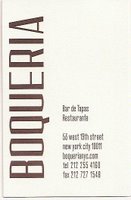 Boqueria
Boqueria
53 West 19th Street, between Fifth and Sixth Avenues
212-255-4160
Fashion in Midtown, Take 2
 After an initial attempt to capture fashion in midtown at 48th and 6th, which was like drawing blood from a stone, I was advised to relocate to Park Avenue in the 40’s for more fertile hunting grounds. Black vinyl or patent leather accessories, bold graphic 60’s prints, more double-breasted blazers, layers, and mixed-up stripes and patterns in menswear were some of the trends in evidence.
After an initial attempt to capture fashion in midtown at 48th and 6th, which was like drawing blood from a stone, I was advised to relocate to Park Avenue in the 40’s for more fertile hunting grounds. Black vinyl or patent leather accessories, bold graphic 60’s prints, more double-breasted blazers, layers, and mixed-up stripes and patterns in menswear were some of the trends in evidence.
Tea at the St. Regis
 Forget the Plaza: all you need to feel like Eloise is tea at the St. Regis. First, there is the old world beauty of the high-ceilinged, gilded dining room itself – Astor Court, so named after John Jacob Astor IV, who built the hotel in 1904. Then the impeccably presented and delicious teas, cakes and tea sandwiches all conspire to make you feel like a very special visitor.
Forget the Plaza: all you need to feel like Eloise is tea at the St. Regis. First, there is the old world beauty of the high-ceilinged, gilded dining room itself – Astor Court, so named after John Jacob Astor IV, who built the hotel in 1904. Then the impeccably presented and delicious teas, cakes and tea sandwiches all conspire to make you feel like a very special visitor.
Tea at the St. Regis also presents a solution to a prevalent New York problem. It’s so easy for visiting relatives to get here, but so seemingly difficult for them to stay the night. Is it the lingering visions of ’70s muggers, or is the high price of hotels even scarier? Whatever the case, if you ever have a visiting aunt in town for just the day, take her here.
 On the day my own aunt arrives, we get to the St. Regis at about 3:30. As soon as we are seated, the tea sommelier appears. She asks what sort of teas we usually drink – black, green, or white? English breakfast or Earl Grey? – then makes some thoughtful recommendations from the 25-plus teas available. We choose the Hao Ya “A” tea (Chinese black), and the St. Regis blend, which she compares to Earl Grey. “Lots of bergamot,” she says, and I think of a favorite perfume. This turns out to be not such a good thing, because the St. Regis blend is so perfumy that I might have just taken a swig of Shalimar. But the tea balances out with more steeping time, and it is beautifully served: poured from individual pots, through an ornate silver strainer set over your teacup, with lemon and a tiny individual jar of honey on a plate alongside.
On the day my own aunt arrives, we get to the St. Regis at about 3:30. As soon as we are seated, the tea sommelier appears. She asks what sort of teas we usually drink – black, green, or white? English breakfast or Earl Grey? – then makes some thoughtful recommendations from the 25-plus teas available. We choose the Hao Ya “A” tea (Chinese black), and the St. Regis blend, which she compares to Earl Grey. “Lots of bergamot,” she says, and I think of a favorite perfume. This turns out to be not such a good thing, because the St. Regis blend is so perfumy that I might have just taken a swig of Shalimar. But the tea balances out with more steeping time, and it is beautifully served: poured from individual pots, through an ornate silver strainer set over your teacup, with lemon and a tiny individual jar of honey on a plate alongside.
 A parade of nibbles arrives. First, a mushroom and artichoke quiche, which is good though a little dry. Fortunately we have taken the sommelier’s advice to ask for water immediately, while the tea brews. The menu has recently been divided into sweets and savories. The savories appear first, not mixed up on the tea tray as used to be the case, but presented almost like sushi, with a Japanese eye for design and color. Little sophisticated and modern twists make the sandwiches interesting. Mint is flecked throughout the cucumber sandwich, and chicken curry salad is spiked with mango. Smoked salmon comes wrapped up into a pinwheel with pumpernickel. The kitchen veers a little too far towards modernity, though, when they include a mini grilled vegetable wrap. I can only wonder which beloved tea sandwich was sacrificed to make room for that one. The new sushi-esque presentation looks pretty but leaves me wanting about five more of the low-guilt cucumber sandwiches. When the tea sandwiches used to be presented en masse, I got to eat much more of them, though admittedly, this might have been because I was eating everyone else’s.
A parade of nibbles arrives. First, a mushroom and artichoke quiche, which is good though a little dry. Fortunately we have taken the sommelier’s advice to ask for water immediately, while the tea brews. The menu has recently been divided into sweets and savories. The savories appear first, not mixed up on the tea tray as used to be the case, but presented almost like sushi, with a Japanese eye for design and color. Little sophisticated and modern twists make the sandwiches interesting. Mint is flecked throughout the cucumber sandwich, and chicken curry salad is spiked with mango. Smoked salmon comes wrapped up into a pinwheel with pumpernickel. The kitchen veers a little too far towards modernity, though, when they include a mini grilled vegetable wrap. I can only wonder which beloved tea sandwich was sacrificed to make room for that one. The new sushi-esque presentation looks pretty but leaves me wanting about five more of the low-guilt cucumber sandwiches. When the tea sandwiches used to be presented en masse, I got to eat much more of them, though admittedly, this might have been because I was eating everyone else’s.
 Then come the sweets. I could subsist forever on good scones and clotted cream, and the St. Regis’ are no exception. Instead of clotted cream, they use Devonshire cream, which is slightly sweeter and more buttery than regular clotted cream. In any case, it’s authentic, and the authenticity of scones and cream is the area where most tea services fall short. Also served with the scones are two kinds of jam and lemon curd, sweet and thick.
Then come the sweets. I could subsist forever on good scones and clotted cream, and the St. Regis’ are no exception. Instead of clotted cream, they use Devonshire cream, which is slightly sweeter and more buttery than regular clotted cream. In any case, it’s authentic, and the authenticity of scones and cream is the area where most tea services fall short. Also served with the scones are two kinds of jam and lemon curd, sweet and thick.
 The tiered tea tray is also laden with lemon cakes, chocolate covered strawberries, and little chocolates filled with raspberry jam. I have to come clean here and admit that I don’t really like sweets, thus the dearth of dessert reviews on this site. But I liked these cakes and candies, and the strawberries were delicious.
The tiered tea tray is also laden with lemon cakes, chocolate covered strawberries, and little chocolates filled with raspberry jam. I have to come clean here and admit that I don’t really like sweets, thus the dearth of dessert reviews on this site. But I liked these cakes and candies, and the strawberries were delicious.
By the time we leave, a good hour and a half after we arrived, Astor Court is packed with tea takers. Some of them are drinking champagne with their cakes and pastries. Marie Antoinette would approve.
 The St. Regis Hotel
The St. Regis Hotel
2 East 55th Street, between Madison and Fifth Avenues
212-753-4500
Madison Avenue, Upper East Side
 Big bags and little dogs, double-breasted coats, and lots of leopard add some panache to the fuddy-duddy fashion of the Upper East Side, where riding boots and Barbour jackets never went out of style.
Big bags and little dogs, double-breasted coats, and lots of leopard add some panache to the fuddy-duddy fashion of the Upper East Side, where riding boots and Barbour jackets never went out of style.
Kittichai
CLOSED
 “That was not great,” says a matronly woman at the corner table, breaking out of Italian for a moment to address her waiter in English.
“That was not great,” says a matronly woman at the corner table, breaking out of Italian for a moment to address her waiter in English.
“Too spicy?” he asks.
“There was spice?” she says pointedly. She strikes me as the kind of Italian lady who would play a ruthless game of chicken on the narrow sidewalks of Florence, preferring to drive any oncoming passersby onto the street rather than move her umbrella one inch in the pouring rain. As an unsure foreign exchange student, I always ended up in the gutter. Now she turns to her dining companion and switches back into Italian. I expect her to leave in a huff. But no: she lingers over coffee for at least another forty-five minutes, seeming to enjoy the place.
Such is the mystique of Kittichai. We know it’s not all it’s cracked up to be, so why stick around? For one thing, while the food may not be buonissimo anymore, it still holds its own. It is to Kittichai’s advantage – one that is sometimes abused – that there are so few good Thai places in NYC and so many bad ones. In the area around NYU, for instance, you could throw a brick and hit some watery tom kha gai, bland pad thai, and cloyingly sweet curry all in one blow. There is such a proliferation of bad Thai that many people don’t even realize it’s bad anymore. Kittichai is good by comparison, but it can leave you wondering if it might be “not great.”
 So how to unravel the mystery of its appeal? There is something extraordinarily pleasing about the space itself. At night, the low lighting gives way to the flickering candles that circulate gently on a square pool in the center of the room. The banquettes all face the main action, which can be interesting, since the restaurant belongs to the hotel 60 Thompson, a convenient stop-off point for celebrities, visiting and local. On the night I visited, Damon Wayans was drinking martinis at one table with two industry suits, while Ingrid Sischy held court at the table next to his. We were lucky enough to have the table right across from theirs, perhaps no accident, since our host is a regular at Kittichai.
So how to unravel the mystery of its appeal? There is something extraordinarily pleasing about the space itself. At night, the low lighting gives way to the flickering candles that circulate gently on a square pool in the center of the room. The banquettes all face the main action, which can be interesting, since the restaurant belongs to the hotel 60 Thompson, a convenient stop-off point for celebrities, visiting and local. On the night I visited, Damon Wayans was drinking martinis at one table with two industry suits, while Ingrid Sischy held court at the table next to his. We were lucky enough to have the table right across from theirs, perhaps no accident, since our host is a regular at Kittichai.
 On that night, my back is to the wall, the edges of the square room are softened by the drape of raw silk curtains, the view of the pond’s surface, the flowers dangling above, the candles, the round tables in the center, and the room itself is clear, yet we are tucked away and thus do not feel exposed in any way. Then it strikes me: I am living in a feng shui fantasy! This place is feng shui’d to the nines – the eights, rather. It is carefully engineered to both excite and comfort, and it’s that push-pull that makes Kittichai a sexy dining experience.
On that night, my back is to the wall, the edges of the square room are softened by the drape of raw silk curtains, the view of the pond’s surface, the flowers dangling above, the candles, the round tables in the center, and the room itself is clear, yet we are tucked away and thus do not feel exposed in any way. Then it strikes me: I am living in a feng shui fantasy! This place is feng shui’d to the nines – the eights, rather. It is carefully engineered to both excite and comfort, and it’s that push-pull that makes Kittichai a sexy dining experience.
 Enter the food from stage right. On the Damon-Wayans-Ingrid-Sischy night, sans Italian matron, we order several dishes to share. The salt and pepper rock shrimp is supposed to be phenomenal. The salt and pepper tempura is good, but the shrimp meat itself isn’t particularly exciting, and the two elements don’t come together the way they should. Tuna tartare is a bit sad and dry, probably because it is covered in dry flaky pastry and served alongside a strange contraption of additional dry pastry shells. The tangy beef salad is composed of excellent seared steak, though the extreme
Enter the food from stage right. On the Damon-Wayans-Ingrid-Sischy night, sans Italian matron, we order several dishes to share. The salt and pepper rock shrimp is supposed to be phenomenal. The salt and pepper tempura is good, but the shrimp meat itself isn’t particularly exciting, and the two elements don’t come together the way they should. Tuna tartare is a bit sad and dry, probably because it is covered in dry flaky pastry and served alongside a strange contraption of additional dry pastry shells. The tangy beef salad is composed of excellent seared steak, though the extreme  lime-y-ness of the dressing can overwhelm it. The weird-sounding chicken relish turns out to be a delicious peanuty puree of chicken served alongside delicate fried bread crisps. The fatty peanut flavor gives way to the slow fire of hidden chilies.
lime-y-ness of the dressing can overwhelm it. The weird-sounding chicken relish turns out to be a delicious peanuty puree of chicken served alongside delicate fried bread crisps. The fatty peanut flavor gives way to the slow fire of hidden chilies.
Onto the main courses. After a brief scuffle between the waiter, my friend and me over the preferred serving method of the whole halibut – filleted or not filleted? – I give way to the pro-filleting side and again end up in the gutter. In deference to Western, bone-shy tastes, the fish is cut into bite size chunks before, not after, it is flash fried, which I didn’t realize from the waiter’s description, and which means that it does not retain that succulent meatiness it has when fried whole, bone-in. A successful version of a similar dish can be found at Grand Sichuan, where the fish of the day is served fried, whole, head-on, smothered in bean sauce. At Kittichai, I feel gypped, but only because they pegged us for bone-shy Westerners, which, admittedly, some of us are.
 The curries are fabulous. They exude a sweet heat that makes me spoon the last remaining sauce over little piles of rice even after the sliced chicken and egg noodles of the light yellow curry are gone, and the short ribs in the green curry are just a pile of bones – mostly on my plate.
The curries are fabulous. They exude a sweet heat that makes me spoon the last remaining sauce over little piles of rice even after the sliced chicken and egg noodles of the light yellow curry are gone, and the short ribs in the green curry are just a pile of bones – mostly on my plate.
 We also have a good chili smoked hangar steak, the wok-fried rice with ginger, shitake mushrooms and coriander, which comes very prettily served in half a pineapple, and plain jasmine rice. As all of this is served, our waiter makes sure to point out what each dish is. The steak is steak, the chicken is chicken, and even the rice is revealed to be rice. Eureka! Because I was about to dig into a decorative fried fish head, thinking it was rice.
We also have a good chili smoked hangar steak, the wok-fried rice with ginger, shitake mushrooms and coriander, which comes very prettily served in half a pineapple, and plain jasmine rice. As all of this is served, our waiter makes sure to point out what each dish is. The steak is steak, the chicken is chicken, and even the rice is revealed to be rice. Eureka! Because I was about to dig into a decorative fried fish head, thinking it was rice.
 I return another day at lunchtime, hoping to sample the chocolate short ribs that I later read were amazing and that I had not tried. Sadly, they are not on the lunch menu, but there is an offering of “galangal and chicken coconut soup,” longhand for tom kha gai. I consider myself a tom kha gai aficionado, if not a connoisseur. At the slightest sign of a cold, I order tom kha gai, the Thai version of chicken soup. In a warning sign of what may be true New Yorkiness, plain old chicken soup just won’t do it anymore for me. Kittichai’s version of tom kha gai is creamy, not watery, full of hunks of tender chicken and those whole little straw mushrooms that always remind me of the cutesy cool of Japanese anime. The sweetness of the coconut milk is balanced by the kaffir lime juice and the orange sheen of chili oil on top. For a while, I am enthralled by the tom kha gai. Then I release it back to the attentive waiter, saving some of my appetite for the monkfish.
I return another day at lunchtime, hoping to sample the chocolate short ribs that I later read were amazing and that I had not tried. Sadly, they are not on the lunch menu, but there is an offering of “galangal and chicken coconut soup,” longhand for tom kha gai. I consider myself a tom kha gai aficionado, if not a connoisseur. At the slightest sign of a cold, I order tom kha gai, the Thai version of chicken soup. In a warning sign of what may be true New Yorkiness, plain old chicken soup just won’t do it anymore for me. Kittichai’s version of tom kha gai is creamy, not watery, full of hunks of tender chicken and those whole little straw mushrooms that always remind me of the cutesy cool of Japanese anime. The sweetness of the coconut milk is balanced by the kaffir lime juice and the orange sheen of chili oil on top. For a while, I am enthralled by the tom kha gai. Then I release it back to the attentive waiter, saving some of my appetite for the monkfish.
The staff is attentive indeed. There is a sense you get as a restaurant reviewer, even a blogging one, when you’ve been made. The hair o
n the back of your neck stands up, you’re looking at them, they’re looking at you, and suddenly your water glass is always full. Such is the case at Kittichai the second time around, and this may have been at least part of the explanation for what happens next.
 Because here is the fish I was looking for last time. A tender, flaky, filet is doused in an excellent sauce spiked with hearts of palm, sauteed red onion, and holy basil leaves, whose strange yet distinctive taste permeates the dish. This I pick at slowly, because it is worth savoring.
Because here is the fish I was looking for last time. A tender, flaky, filet is doused in an excellent sauce spiked with hearts of palm, sauteed red onion, and holy basil leaves, whose strange yet distinctive taste permeates the dish. This I pick at slowly, because it is worth savoring.
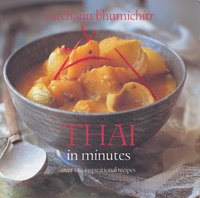 Unlike the Italian lady, I am quite satisfied by the time I get my check. It is only when I’m out on the street, walking further and further away from the restaurant itself that I wonder, how hard is it, anyway, to make tom kha gai? Could I make it myself, using a simple cookbook like this one? But I certainly wouldn’t be able to recreate that monkfish without a lot of practice and perhaps some divine intervention. Most importantly, if I tried this at home, I would be denying myself the pleasure of visiting the restaurant itself. Back in that elusive Bermuda triangle of feng shui’d charm, I’m sure I would fall under the Kittichai spell once again.
Unlike the Italian lady, I am quite satisfied by the time I get my check. It is only when I’m out on the street, walking further and further away from the restaurant itself that I wonder, how hard is it, anyway, to make tom kha gai? Could I make it myself, using a simple cookbook like this one? But I certainly wouldn’t be able to recreate that monkfish without a lot of practice and perhaps some divine intervention. Most importantly, if I tried this at home, I would be denying myself the pleasure of visiting the restaurant itself. Back in that elusive Bermuda triangle of feng shui’d charm, I’m sure I would fall under the Kittichai spell once again.
 Kittichai
Kittichai
60 Thompson Street between Broome and Spring Streets
212-219-2000








